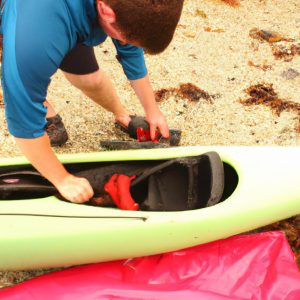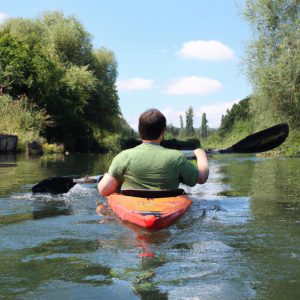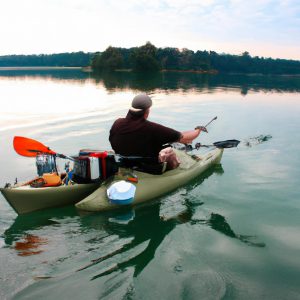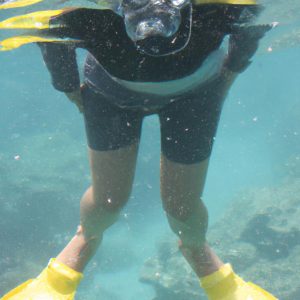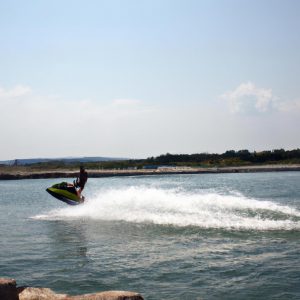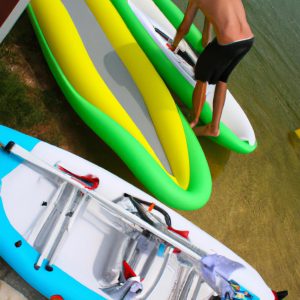Safety Gear for Kayaking: Everything You Need to Know
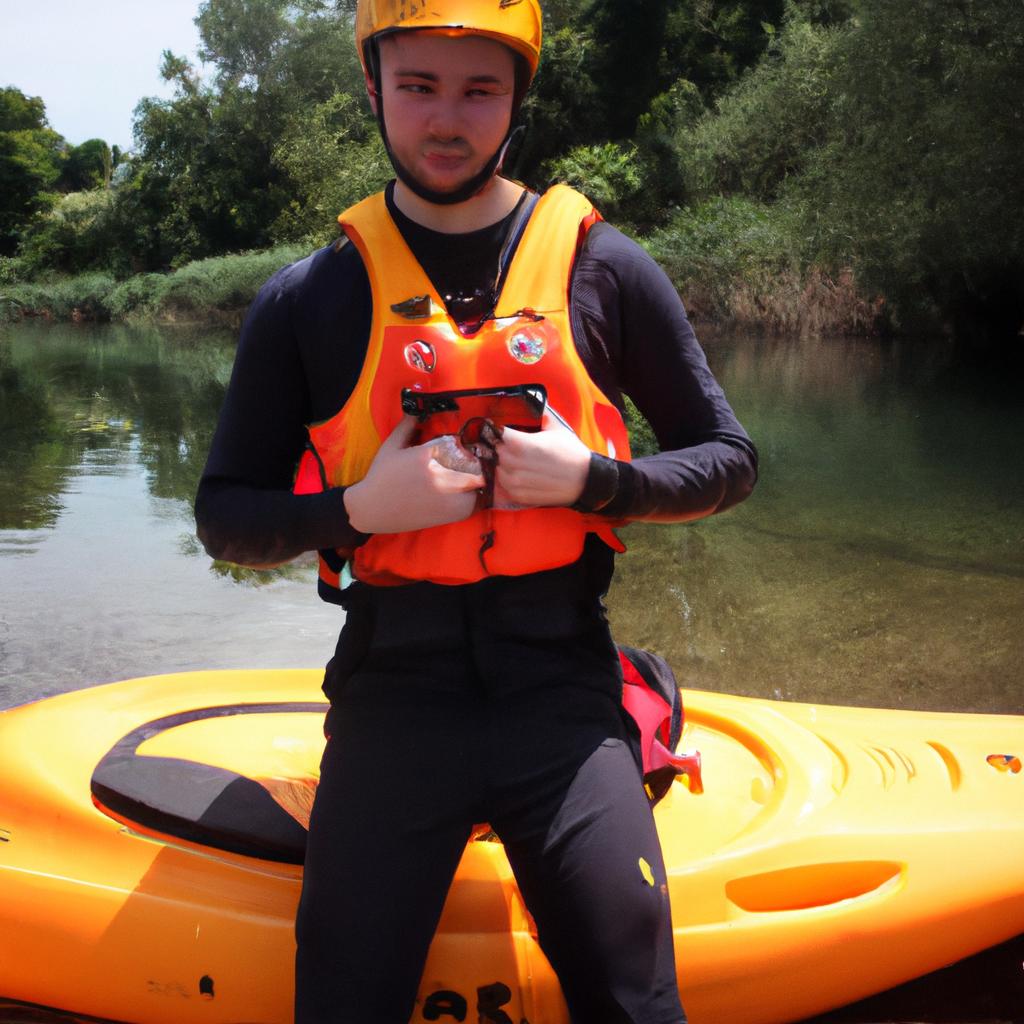
Kayaking is a popular recreational activity that allows individuals to explore waterways and experience the thrill of navigating through rapids or serene lakes. However, like any outdoor endeavor, it comes with its own set of potential risks and hazards. In order to ensure a safe and enjoyable kayaking experience, it is crucial for enthusiasts to familiarize themselves with the necessary safety gear. This article provides a comprehensive guide on the essential equipment required for kayaking, including life jackets, helmets, spray skirts, and more.
Imagine yourself paddling along a tranquil river when suddenly you encounter unexpected rough waters. Without proper safety gear, this situation could quickly turn into a nightmarish ordeal. The importance of wearing appropriate safety gear cannot be overstated as it can mean the difference between life and death in potentially hazardous situations. Life jackets are perhaps the most critical piece of equipment for all kayakers regardless of their skill level or familiarity with the water conditions. They provide buoyancy and keep individuals afloat in case of capsizing or sudden immersion in water.
Another vital component of kayak safety gear is a helmet. While many may associate helmets solely with activities such as biking or skateboarding, they play an equally significant role in protecting kayakers from head injuries caused by collisions with rocks or other objects in the water. A helmet should be worn whenever kayaking in fast-moving rivers or areas with potential obstacles, such as rapids or rocky sections. It provides essential protection for your head and can prevent serious injuries.
Spray skirts are another essential piece of safety gear for kayakers, especially those venturing into rougher waters. These skirts are designed to fit snugly around the cockpit opening of the kayak, creating a watertight seal between the paddler and the boat. This prevents water from entering the kayak, keeping you dry and ensuring better control over your craft. In situations where waves crash over the deck of your kayak, a spray skirt can help keep you protected from getting swamped.
In addition to these primary safety items, there are other pieces of equipment that can enhance your safety on the water. A paddle float is a useful tool that assists in self-rescue if you find yourself capsized or unable to re-enter your kayak from deep water. It attaches to one end of your paddle, creating an outrigger-like support that helps stabilize your kayak while you climb back in.
A bilge pump is another handy device that aids in removing any accumulated water from inside your kayak’s hull. Paddling through waves or during wet conditions can result in some water making its way into the boat, and having a bilge pump allows you to quickly remove it, keeping your kayak buoyant and easier to maneuver.
Lastly, a whistle is a simple yet effective tool for attracting attention when needed. Whether you’re signaling for help or alerting others to potential hazards, a whistle can be heard over long distances and is an important communication tool while on the water.
Remember that safety should always be a priority when engaging in any outdoor activity, including kayaking. By equipping yourself with the necessary safety gear and taking appropriate precautions before hitting the water, you can ensure a safe and enjoyable kayaking experience every time.
Essential Safety Gear for Kayaking
Imagine this scenario: you’re out on a serene lake, paddling your kayak under the warm sun. The water is calm and inviting, and you’re surrounded by breathtaking natural beauty. Suddenly, dark clouds roll in, and before you know it, a powerful storm unleashes its fury upon you. This unexpected turn of events highlights the importance of having the right safety gear when embarking on a kayaking adventure.
When venturing into the great outdoors, it is crucial to be prepared with essential safety gear that can help protect you from potential risks. One such item is a personal flotation device (PFD), commonly known as a life jacket or life vest. A PFD should always be worn while kayaking to ensure buoyancy in case of capsizing or being thrown overboard. It serves as a vital lifeline that keeps you afloat until help arrives.
In addition to wearing a PFD, there are several other key pieces of safety equipment every kayaker should have within easy reach. These include:
- A whistle or signaling device: In an emergency situation, sound carries far across open water than calls for help alone. Having a whistle or signaling device allows you to attract attention quickly and alert others to your distress.
- A bilge pump: This handheld tool helps remove excess water from inside your kayak if it becomes swamped. By keeping your kayak free of water accumulation, you maintain stability and prevent further hazards.
- A marine-grade first aid kit: Accidents can happen even during seemingly tranquil adventures. Carrying a well-stocked first aid kit designed specifically for boating activities ensures that minor injuries can be promptly treated until professional medical assistance is available.
To emphasize the significance of these items visually, consider their impact through this table:
| Safety Gear | Purpose | Importance |
|---|---|---|
| Personal Flotation Device (PFD) | Provides buoyancy and keeps you afloat | Vital for survival |
| Whistle or Signaling Device | Attracts attention in emergency situations | Crucial for communication |
| Bilge Pump | Removes excess water from kayak | Ensures stability |
| First Aid Kit | Treats minor injuries until help arrives | Essential for immediate care |
By having these essential safety gear items readily available, kayakers can mitigate risks and increase their chances of safely navigating through unexpected challenges. Remember that being prepared is not only responsible but also enhances the overall enjoyment of your kayaking experience.
Transitioning seamlessly into the subsequent section about PFDs: The Most Important Safety Gear, it becomes evident that one item stands out as paramount among all others when it comes to ensuring kayaker safety – the personal flotation device (PFD).
PFDs: The Most Important Safety Gear
Ensuring Safety on the Water: Paddling Gloves and Footwear
Imagine this scenario: You’re out kayaking on a beautiful sunny day, navigating through choppy waters. Suddenly, you hit a rock hidden beneath the surface, causing your kayak to tip over. As you struggle to right yourself and get back into the kayak, your hands scrape against sharp barnacles clinging to nearby rocks. If only you had been wearing paddling gloves, this mishap could have been easily avoided.
-
Paddling Gloves: Essential for protecting your hands from blisters, cuts, and abrasions while kayaking, paddling gloves provide added grip on wet surfaces. Made with durable materials such as neoprene or synthetic leather, these gloves offer both protection and flexibility. They are designed specifically for water sports activities like kayaking and canoeing.
-
Footwear: Proper footwear is crucial when engaging in any water-based activity. Slippery rocks or other hazards lurking below the water’s surface can pose serious risks to unprotected feet. Investing in suitable footwear will not only protect your feet but also enhance your overall comfort and stability while kayaking.
To further emphasize the importance of safety gear for kayaking, consider the following bullet points:
- Paddling gloves significantly reduce the risk of hand injuries.
- Good-quality shoes or water sandals improve traction and prevent slips.
- Using appropriate safety gear enhances confidence and enjoyment during kayaking trips.
- Neglecting safety equipment may lead to accidents that can be easily prevented.
Additionally, take a look at this table highlighting some key features of popular paddling gloves available on the market:
| Brand | Material | Features |
|---|---|---|
| NRS | Neoprene | Thermal insulation; reinforced palms |
| Level Six | Synthetic | Breathable fabric; adjustable wrist straps |
| Stohlquist | Neoprene | Seamless palm design; form-fitting |
| Kokatat | Synthetic | UV-resistant fabric; articulated fingers |
By investing in paddling gloves and appropriate footwear, you can significantly reduce the risk of injuries while enhancing your overall kayaking experience. In our next section, we will explore another crucial safety gear item: choosing the right helmet for kayaking. So let’s dive into this topic to ensure that you have all the knowledge necessary to make an informed decision when it comes to protecting your head on the water.
Choosing the Right Helmet for Kayaking
Section Title: “Choosing the Right Helmet for Kayaking”
Imagine a kayaker navigating through rough waters, their helmet providing crucial protection against potential head injuries. The right helmet is an essential safety gear for any kayaker, ensuring their well-being amidst challenging conditions. This section will delve into the factors to consider when selecting a suitable helmet for kayaking.
Factors to Consider:
-
Fit and Comfort:
A properly fitting helmet is vital to ensure maximum protection and comfort during kayaking expeditions. It should snugly fit on the head without being too tight or loose, allowing enough room for adjustments with straps or padding if needed. Opting for helmets with adjustable features can accommodate various head sizes and shapes, enhancing both safety and user satisfaction. -
Material:
Helmets designed specifically for water sports are typically constructed from durable materials such as ABS plastic or fiberglass composite. These materials offer excellent impact resistance while remaining lightweight, reducing strain on the wearer’s neck during extended periods of paddling. Additionally, helmets often feature foam cushioning inside that provides additional shock absorption in case of collisions or falls. -
Certification Standards:
When choosing a kayak helmet, it is important to look for certifications indicating compliance with industry safety standards. Certifications like CE EN 1385 or ASTM F1492 assure buyers that the product has undergone rigorous testing and meets specific criteria related to impact attenuation and buoyancy requirements.
Bullet Point List – Benefits of Wearing a Suitable Kayak Helmet:
- Protects your head from potential impacts during capsizing or colliding with rocks.
- Reduces the risk of traumatic brain injuries caused by severe blows.
- Enhances overall confidence and peace of mind while tackling challenging whitewater rapids.
- Sets a good example for other kayakers regarding responsible safety practices.
Table – Comparison of Common Kayak Helmet Materials:
| Material | Pros | Cons |
|---|---|---|
| ABS Plastic | Affordable and durable | Less impact resistance compared to composite materials |
| Fiberglass | Lightweight and high strength | Can be more expensive |
| Carbon Composite | Exceptionally strong and light | Higher cost, may not fit every budget |
Transition into the next section:
With appropriate personal flotation devices (PFDs) and helmets in place, kayakers can focus on another crucial aspect of their safety gear: protective clothing. The right attire ensures optimal comfort, protection against the elements, and safeguards against potential hypothermia. Let’s explore the importance of wearing suitable protective clothing for kayaking adventures.
The Importance of Wearing Protective Clothing
Picture this scenario: You’re out on a kayaking trip, enjoying the thrill of navigating through rough waters. Suddenly, you hit a rock and capsize. As you struggle to regain control, your body is exposed to the elements – cold water rushing in, sharp rocks grazing against your skin. This hypothetical situation highlights the criticality of wearing protective clothing while kayaking.
When it comes to protecting yourself from potential dangers on the water, wearing appropriate gear can make all the difference. Here are some key reasons why investing in protective clothing should be a priority for every kayaker:
-
Shielding Against Hypothermia:
- Neoprene wetsuits or drysuits provide insulation by trapping a thin layer of water between your body and the suit.
- Prevents heat loss during prolonged exposure to cold water, reducing the risk of hypothermia.
- Even in warmer climates, unexpected capsizing or extended time spent in cool waters can quickly lead to dangerous drops in body temperature.
-
Guarding Against Abrasions and Cuts:
- A durable paddling jacket made from reinforced materials shields against scrapes caused by contact with rocks and branches.
- Paddling pants protect legs from abrasions when rubbing against kayak surfaces.
- Gloves offer additional hand protection while gripping paddles or maneuvering around obstacles.
-
Enhancing Visibility & Safety:
- Choose brightly colored clothing that enhances visibility for other boaters on the water.
- Reflective strips on jackets or life vests increase visibility during low-light conditions or emergencies.
- Opt for garments with built-in whistle clips for easy access to signaling devices if needed.
-
Keeping Comfortable Under Changing Conditions:
Base Layer Mid-Layer Outer Layer Moisture-wicking Insulating Waterproof Breathable Quick-drying Wind-resistant Lightweight Flexible Durable Odor-resistant
Investing in suitable kayaking clothing not only provides protection but also ensures comfort and flexibility, allowing you to focus on the joys of your paddling adventure.
As you can see, wearing protective clothing while kayaking is essential for safeguarding yourself against various risks. The right gear helps maintain body temperature, prevents injuries, improves visibility, and offers comfort under changing conditions. Now, let’s dive into the next section about Safety Accessories Every Kayaker Should Have, which will further enhance your safety on the water.
Safety Accessories Every Kayaker Should Have
Transitioning from the importance of wearing protective clothing, let us now explore the essential safety accessories that every kayaker should have. To illustrate their significance, consider a hypothetical scenario where Sarah, an experienced kayaker, finds herself in rough waters after being caught off guard by sudden weather changes. Without these safety accessories, her situation could quickly become perilous.
First and foremost, a personal flotation device (PFD) is an absolute must-have for any kayaker. In turbulent conditions like those faced by Sarah, the PFD provides buoyancy and ensures that she remains above water even if she capsizes or becomes fatigued. Additionally, it serves as a visible marker to aid rescue teams in locating her swiftly during emergencies. Remember, investing in a well-fitted and Coast Guard-approved PFD can be a lifesaver.
Equally important is having a reliable signaling device on hand. This could include items such as whistles or air horns which are loud enough to alert nearby boats or other individuals of distress signals. You never know when you may need help while out on the water, so ensure your signaling devices are easily accessible and functional at all times.
Furthermore, carrying a first aid kit is crucial for addressing minor injuries or medical emergencies while kayaking. Accidents happen unexpectedly, and having basic medical supplies readily available allows you to treat wounds promptly until professional assistance arrives. Consider including essentials like bandages, antiseptic wipes, adhesive tape, pain relievers, and any necessary medications specific to individual needs.
Lastly, investing in a waterproof flashlight can prove invaluable during low-light conditions or unexpected nightfall. Navigating through unfamiliar territory or signaling for help becomes significantly easier with this small yet powerful tool at hand. Opt for one with long battery life and multiple light settings to cater to different situations effectively.
- Personal Flotation Device (PFD): Ensures buoyancy and visibility.
- Signaling Devices: Whistles, air horns, or other loud devices to attract attention.
- First Aid Kit: Equipped with necessary supplies for addressing injuries and medical emergencies.
- Waterproof Flashlight: Essential for low-light conditions and signaling.
To summarize, safety accessories are indispensable for kayakers. They not only enhance personal safety but also increase the chances of a successful rescue in case of emergencies. By having appropriate gear like PFDs, signaling devices, first aid kits, and waterproof flashlights readily available, you can navigate challenging situations more confidently while enjoying your kayaking adventures.
Transitioning into the next section about “Tips for Properly Maintaining Your Safety Gear,” it is essential to ensure that your equipment remains in optimal condition throughout its lifespan.
Tips for Properly Maintaining Your Safety Gear
Having the right safety gear is crucial when it comes to kayaking. In addition to having the essential safety accessories, proper maintenance of your equipment ensures optimal performance and longevity. By following these tips, you can enjoy a safe and worry-free paddling experience.
Section:
Imagine this scenario: you are out on the water, enjoying a serene day of kayaking, when suddenly a strong gust of wind sweeps in unexpectedly. The calm waters quickly turn choppy, making it challenging to control your kayak. This is where having the appropriate safety gear becomes imperative. Whether you are an experienced kayaker or a beginner, certain items should always be within reach to ensure your safety in unpredictable situations.
Consider including these key items as part of your safety gear arsenal:
- Personal Flotation Device (PFD): A PFD, also known as a life jacket, is perhaps the most critical piece of equipment that every kayaker should wear at all times while on the water. It provides buoyancy and helps keep you afloat if you capsize or encounter difficulties.
- Whistle or Air Horn: These audible signaling devices are small but mighty tools that can attract attention from other boaters or rescue teams during emergencies.
- Bilge Pump: A bilge pump allows you to remove water from inside your kayak efficiently. Effective removal prevents excess weight accumulation and maintains stability.
- First Aid Kit: Accidents happen even in the safest environments. Having a well-stocked first aid kit readily available equips you with basic medical supplies necessary for treating minor injuries until professional help arrives.
Ensure your peace of mind by incorporating these vital safety measures into your kayaking routine:
- Regularly inspecting and maintaining your safety gear.
- Updating and replacing equipment as needed.
- Staying informed about weather conditions and potential hazards in the area.
- Practicing self-rescue techniques to enhance your ability to handle emergencies.
Emotional table:
| Safety Gear Maintenance | Why It Matters |
|---|---|
| Inspect for damage | Ensures optimal performance of equipment |
| Clean after each use | Prevents deterioration and extends lifespan |
| Store properly | Protects gear from environmental elements |
| Replace worn-out items | Maintains effectiveness during critical situations |
In conclusion, having the right safety gear is essential for every kayaker. By being prepared with the necessary accessories such as a PFD, whistle or air horn, bilge pump, and first aid kit, you can navigate challenging situations on the water more confidently. Additionally, prioritizing regular maintenance and following proper storage practices will ensure that your safety gear remains reliable when you need it most. Stay safe and enjoy your kayaking adventures!

